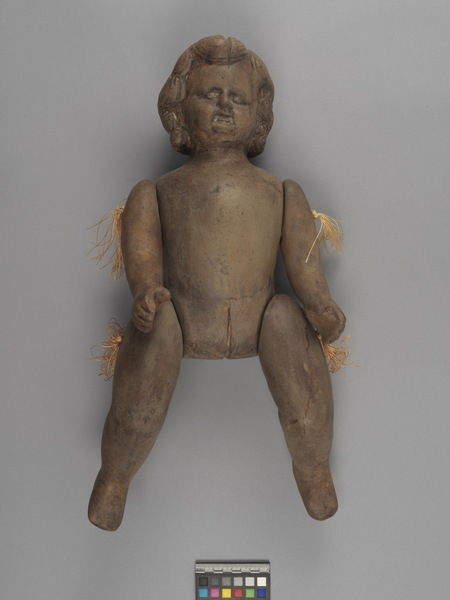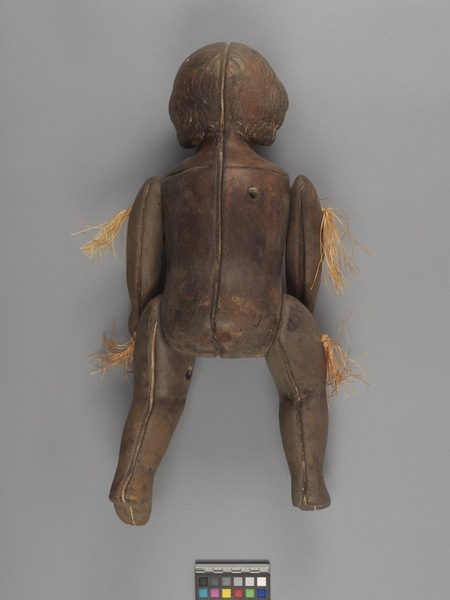Doll Mould Item Number: 3289/85 from the MOA: University of British Columbia


Description
Large, heavy, ceramic articulated female doll mould. The arms and legs are tied to the torso with fibre thread, the ends of which extend out from the thighs and shoulders as tassels. The doll is shown as wearing a hat, with short curly hair.
History Of Use
Moulds like these (made of ceramic or plaster) are used to make papier mache dolls in Central Mexico. This tradition dates to the mid-19th century, and is said to have been a popular, inexpensive alternative to European style porcelain dolls. The paper doll, once dried, is painted with a short or no sleeved suit with short legs, in a variety of colours. The hair and face are painted, and decorated with glitter and sequins. All of these dolls bear names written on their clothing. The clothing is also often painted with Otomi style floral patterns. In size these dolls can range from a few centimetres in height to a metre. They are known as muñecas de cartoneria or ‘lupita’ dolls. There is a corresponding male version, the ‘pepito,’ which, historically, has been less popular. They garnered increased popularity in the mid-20th century, thanks to their appearance in work by Diego Rivera. They became less popular after the introduction of commercial plastic dolls but their production has been supported as a national craft by CONACULTA (Mexico’s governmental cultural commission). There are various narratives surrounding the original use of dolls such as these (outside the toy market). One such version is that brothels commissioned dolls with the names of the prostitutes painted on them and that available workers were ‘advertised’ in the shop window using the doll.
Item History
- Made in Celaya, Guanajuato, Mexico before 1999
- Collected by Laura Osorio between 2017 and 2018
- Owned by Laura Osorio before April 11, 2018
- Received from Laura Osorio (Seller), Museum of Anthropology Exhibitions Budget (Funding source) and Michael O'Brian Family Foundation (Funding source) on April 11, 2018
What
Who
- Culture
- Mexican
- Field Collector
- Laura Osorio
- Previous Owner
- Laura Osorio
- Received from
- Laura Osorio (Seller), Museum of Anthropology Exhibitions Budget (Funding source) and Michael O'Brian Family Foundation (Funding source)
Where
- Holding Institution
- MOA: University of British Columbia
- Made in
- Celaya, Guanajuato, Mexico
When
- Creation Date
- before 1999
- Collection Date
- between 2017 and 2018
- Ownership Date
- before April 11, 2018
- Acquisition Date
- on April 11, 2018
Other
- Item Classes
- ceramics
- Condition
- good
- Accession Number
- 3289/0085